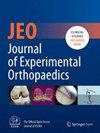Impact of screw design on refixation of solid avulsion fractures of the posterior cruciate ligament—A biomechanical feasibility study
Abstract
Purpose
Avulsion fractures of the posterior cruciate ligament (PCL) are commonly treated with refixation. Headless compression screws (HCS) offer benefits, compared to conventional techniques, such as reduced material irritation and option of bioabsorbable materials, possibly avoiding implant removal. Proofing its clinical applicability, the authors hypothesized that (1) biomechanical properties of HCS would be comparable to conventional techniques and (2) magnesium-based HCS would provide comparable properties to titanium HCS.
Study Design
Controlled laboratory study.
Methods
Forty fresh frozen porcine knees were dissected keeping the menisci and ligaments intact. A solid avulsion fracture of the tibial PCL (20 mm [length] × 20 mm [width] × 10 mm [depth]) was created with a chisel. Specimens were randomized into four groups: (1) the native PCL, the tibial PCL avulsion refixed with parallel arranged, (2) two 3.5 mm cortical screws with washer (Ti-CS), (3) two titanium headless compression screws (Ti-HCS) or (4) two magnesium based headless compression screws (Mg-HCS). Femur and tibia were mounted in a universal uniaxial testing machine (Zwick) simulating a posterior drawer testing, by performing axial load on the femur while the tibia was fixed in 90° flexion. After preconditioning, 500 cycles (200 mm/min) were performed with 10–100 N, followed by load-to-failure (LTF). Key parameters measured included stiffness, yield load, LTF and cyclic displacement. Differences were analyzed using an analysis of variance with a significance level of p < 0.05. The macroscopic failure mode was documented.
Results
LTF of the intact PCL (1982.0 ± 285.4 N; p ≤ 0.001) significantly exceeded that of all refixations. Whereas LTF of Ti-CS (1034.8 ± 236.1 N) significantly (p ≤ 0.01) exceeded those of HCS, no significance was seen between titanium (Ti-HCS: 693.9 ± 220.5 N) or magnesium (Mg-HCS: 686.7 ± 174.6 N) based HCS. No significant differences were found among the refixation methods regarding cyclic displacement or yield load. Stiffness for the Ti-CS (144.0 ± 15.4 N/mm), Ti-HCS (150.0 ± 22.9 N/mm) and Mg-HCS (170.0 ± 20.9 N/mm) was lower than that of the intact PCL (190.9 ± 8.6 N/mm). Failure modes varied, with the Ti-CS group showing PCL tears and the HCS groups always experiencing fragment luxation.
Conclusion
In our biomechanical model, all fixation techniques demonstrated inferior biomechanical properties compared to the native PCL. Both HCS exhibited similar displacement, stiffness, and yield load values but showed a significantly lower LTF with fragment dislocation compared to conventional screws. Whether this difference is clinically relevant cannot be determined with this model as the porcine model only allows limited transfer into the clinical setting but might limit rehabilitation in the application of HCS in cases of solid avulsion fractures. Further clinical and in vivo studies should be followed to further differentiate the optimized fragment refixation technique.
Level of Evidence
There is no level of evidence as this study was an experimental laboratory study.


 求助内容:
求助内容: 应助结果提醒方式:
应助结果提醒方式:


